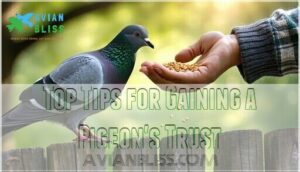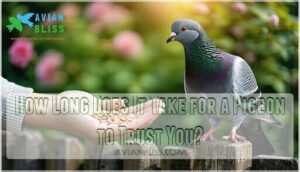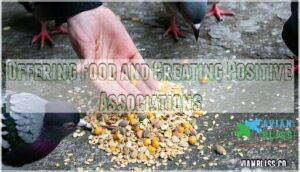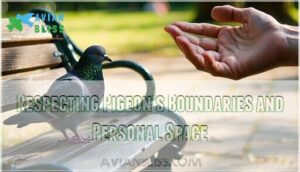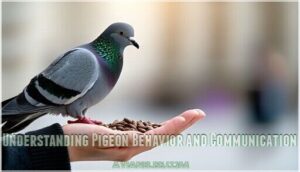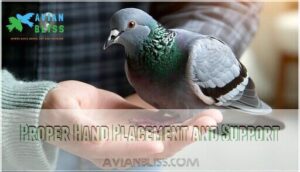This site is supported by our readers. We may earn a commission, at no cost to you, if you purchase through links.
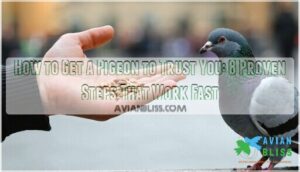 Getting a pigeon to trust you starts with patience and food.
Getting a pigeon to trust you starts with patience and food.
Sit quietly in their space, offering seeds or breadcrumbs without making sudden movements.
These clever birds watch your every move, so consistency is key.
Visit the same spot daily, speaking softly while they eat nearby.
Don’t chase or grab them – that’s like trying to befriend someone by tackling them at a coffee shop.
Instead, let them approach you naturally.
Most pigeons warm up within a week if you’re gentle and predictable.
They’ll eventually eat from your hand, recognizing you as their reliable snack provider rather than a threat.
Table Of Contents
- Key Takeaways
- How to Get a Pigeon to Trust You
- Top Tips for Gaining a Pigeon’s Trust
- How Long Does It Take for a Pigeon to Trust You?
- Building Trust With Wild Pigeons
- Understanding Pigeon Behavior and Communication
- Providing Proper Care and Nurturing for Pet Pigeons
- Techniques for Handling and Interacting With Pet Pigeons
- Rescuing Lost or Injured Pigeons
- Frequently Asked Questions (FAQs)
- Do pigeons trust humans?
- How do you get pigeons to trust you?
- How do you get a pigeon’s confidence?
- How long does it take a pigeon to trust you?
- How do pigeons develop trust?
- How to tame a pigeon?
- How do you gain a pigeon’s trust?
- How do you bond with a pigeon?
- How do you get a pigeon to come to you?
- How to tell if a pigeon trusts you?
- Conclusion
Key Takeaways
- Start with food and patience – You’ll need to offer seeds or breadcrumbs consistently while sitting quietly in the same spot daily, letting the pigeon approach you naturally rather than chasing or grabbing them.
- Move slowly and speak softly – You can’t rush the process since sudden movements or loud noises will destroy any trust you’ve built, so practice calm gestures and maintain a predictable routine.
- Let them set the pace – You should respect their boundaries and personal space, allowing the pigeon to initiate interactions and approach you when they’re comfortable rather than forcing contact.
- Consistency builds recognition – You’ll accelerate trust-building by visiting at the same time daily and maintaining gentle, predictable behavior since pigeons remember faces and associate your presence with positive experiences.
How to Get a Pigeon to Trust You
Getting a pigeon to trust you isn’t as tricky as teaching your cat to fetch, but it does require understanding their unique behavior patterns and creating the right environment for bonding.
You’ll need patience, consistency, and a few proven techniques that work with their natural instincts rather than against them.
Understanding Pigeon Behavior
Understanding pigeon behavior is like learning a new language—one filled with cooing conversations and feather displays.
Building trust with a pigeon is like earning a friendship—slow, genuine, and built on mutual respect and understanding.
These intelligent birds use pigeon communication through head bobs, wing flaps, and soft coos to express their feelings. Their social structures mirror our own neighborhoods, with established hierarchies and friendships.
Watch for comfort signals like relaxed feathers and gentle preening, which show they’re at ease. Pigeons excel at recognizing humans and remembering faces, making your consistent presence key to pigeon trust building and developing lasting bird behavior connections.
Displays of affection such as beak rubbing indicate trust are important indicators of a strong bond, showcasing the importance of trust in pigeon relationships.
Creating a Safe and Comfortable Environment
A comfortable pigeon feels like royalty in their own castle.
Start with proper cage size – your feathered friend needs room to stretch those wings without bumping into walls. Strategic perch placement at varying heights gives them options, just like choosing the best seat in a movie theater.
Noise reduction is essential since pigeons startle easily – think library quiet, not construction site chaos.
Predator protection means secure latches and solid barriers against cats or hawks. Temperature control between 65-75°F keeps them cozy.
This safe environment becomes the foundation for pigeon trust, making your bird feel secure enough to bond with you, creating a sense of royalty.
Patience and Consistency in Interactions
Trust isn’t built overnight with pigeons – it’s a marathon, not a sprint.
Building pigeon trust is like planting seeds—patience waters the garden, consistency tends the soil.
Your pigeon trust journey requires unwavering patience and consistency to see real gradual progress.
One rushed move can cause avoiding regression in all your hard work.
Here’s your consistent approach for building confidence:
- Visit at the same time daily – routine benefits create predictability
- Move slowly and speak softly – sudden gestures destroy pigeon trustbuilding
- Let them set the pace – forced interactions backfire
- Reward small wins – celebrate when they don’t flee
Proper pigeon handling means respecting their timeline, not yours.
Top Tips for Gaining a Pigeon’s Trust
Building trust with pigeons requires patience, consistency, and understanding their natural behaviors, which can take anywhere from a few days to several weeks depending on the bird’s personality.
You’ll need to master five key techniques that work together: choosing the right location, offering food strategically, moving slowly and deliberately, letting pigeons approach you first, and eventually progressing to gentle physical contact once they’re comfortable with you and your presence, utilizing strategic approaches to build trust.
Choosing The Right Spot
You’ll want to scout the perfect spot before attempting any trust-building. Location matters more than you’d think. Choose areas with natural shelter and minimal foot traffic to guarantee pigeon safety.
| Factor | Ideal Choice | Why It Works |
|---|---|---|
| Safe Location | Parks, quiet courtyards | Reduces stress, allows natural behavior |
| Weather Protection | Covered areas, building overhangs | Keeps pigeons comfortable during visits |
| Accessibility | Ground level, open spaces | Easy approach without cornering birds |
This creates the calm atmosphere pigeons need.
Offering Food as a Gesture of Trust
Food becomes your secret weapon in winning over these feathered friends. Think of it as your universal peace offering – pigeons naturally link food with safety and friendship.
Smart Hand-Feeding Methods start with holding treats in your open palm, letting them approach on their terms. This creates positive Food Association that builds pigeon trust over time.
Your Feeding Schedule matters too. Regular meals at consistent times show you’re reliable. Choose Safe Foods like seeds, grains, and cracked corn that match their Dietary Needs. Skip the bread – it’s junk food for pigeons.
Notably, studies suggest that food similarity matters even in negotiation settings.
Start by scattering food nearby, then gradually offer it closer to you. Each successful pigeon feeding session strengthens your bond. Remember, handfeeding pigeons requires patience – they’re sizing you up just as much as you’re trying to connect with them through pigeon trustbuilding.
- Scatter-to-Hand Progression: Begin by tossing food nearby, then slowly move to palm feeding
- Hunger-Time Advantage: Offer treats when they’re naturally hungry for faster trust development
Avoiding Sudden Movements
After successfully offering food, your next challenge involves mastering the art of stillness. Think of yourself as a statue—pigeons notice every twitch and sudden jerk. Quick movements trigger their flight response faster than you can blink.
| Movement Type | Pigeon’s Reaction |
|---|---|
| Sudden hand gestures | Immediate flight or defensive posturing |
| Quick head turns | Heightened alertness and retreat |
| Rapid walking | Complete avoidance of your presence |
| Loud foot stomping | Panic response and scattering |
| Abrupt standing | Loss of trust and increased wariness |
Practice slow gestures and predictable actions. Your calm approach creates a quiet environment where pigeon trustbuilding thrives through patience and gentle handling.
Gradually Allowing Pigeons to Approach
Building on your calm demeanor, you’ll want to let your pigeon make the first move. Think of it like dating—nobody likes a pushy suitor! Create space between you and your feathered friend, then wait for them to show interest.
Here’s your patience-powered approach:
- Place food progressively closer to where you’re sitting
- Remain still while they evaluate the situation
- Watch their body language for comfort signals
- Respect their personal bubble when they hesitate
- Celebrate small victories like head tilts or steps forward
This slow-and-steady method builds genuine trust through positive reinforcement and boundary respect.
Gentle Petting and Bonding Activities
Once your pigeon approaches you willingly, it’s time to introduce gentle petting techniques that strengthen your bond.
Start with soft strokes along their back using just your fingertip – this mimics how pigeons naturally preen each other.
Watch for comfort signs like relaxed feathers and soft cooing, which show they’re enjoying the safe touch.
Pigeons thrive when kept in predator-proof outdoor aviaries, if you plan to house them outside.
Try simple bonding games like "The Blinking Game" where you slowly blink at your pigeon – they often blink back!
Hand training with treats creates positive reinforcement, making trust exercises feel natural and rewarding for both of you.
How Long Does It Take for a Pigeon to Trust You?
Time and patience really matter when building pigeon trust.
Trust Factors include the bird’s past experiences and Pigeon Personalities – some warm up in days, others need weeks or months.
Handling Impact plays a huge role; gentle interactions speed things up, while rough treatment sets you back.
Wild vs. Pet pigeons show different Building Duration timelines too.
Here’s what affects pigeon trust building speed:
- Individual personality – Bold birds trust faster than shy ones
- Previous human contact – Socialized pigeons adapt quicker
- Your consistency – Daily visits build stronger bonds
- Environmental stress – Calm settings accelerate trust
Recognizing relaxed feather positions is also a key indicator of trust.
Building Trust With Wild Pigeons
Wild pigeons require a different approach than their domesticated cousins, since they haven’t grown up around humans and naturally view us as potential threats.
You’ll need to move slowly and show extra patience, but with consistent visits and the right food offerings, even the most skittish street pigeon can learn to see you as a friend rather than a predator.
Establishing a Relationship With Regular Visits
Regular visits work like magic for building trust with wild pigeons.
Your consistent presence becomes their comfort zone – think of it as being the friendly neighbor who always waves hello.
Stick to a predictable schedule, visiting the same spot daily.
During these visits, practice quiet observation from a respectful distance, allowing gradual interaction as the pigeon grows comfortable.
This patient approach to pigeon bonding creates a safe approach that doesn’t overwhelm your feathered friend.
| Visit Frequency | Interaction Level | Expected Progress |
|---|---|---|
| Daily (Week 1) | Quiet observation only | Pigeon notices your presence |
| Daily (Week 2) | Soft talking, slow movements | Reduced fear responses |
| Daily (Week 3) | Closer positioning | Pigeon stays when you arrive |
| Daily (Week 4) | Hand gestures, gentle sounds | Active acknowledgment of you |
| Twice daily (Month 2+) | Interactive pigeon routine established | Trust foundation solidified |
Reorganizing the visits into a daily routine and eventually a twice daily interaction can significantly enhance the bonding experience, leading to a strong foundation of trust between you and the pigeon.
Offering Food and Creating Positive Associations
Once you’ve established regular visits, food becomes your golden ticket to a pigeon’s heart. Consistent feeding creates powerful positive associations that accelerate pigeon trustbuilding.
Start by scattering seeds on the ground, letting them approach naturally. Hand-feeding benefits become apparent as hungry pigeons associate your presence with good things.
Choose the right pigeon food for maximum impact:
- Sunflower seeds and millet (their absolute favorites)
- Cracked corn and dried peas
- Uncooked rice or barley
- Whole grains without salt or seasoning
- Fresh bread pieces (occasionally, not daily)
Positive reinforcement through pigeon feeding works like magic—they’ll remember you’re the snack provider.
Respecting Pigeon’s Boundaries and Personal Space
While food creates positive bonds, respecting boundaries takes your pigeon relationship to the next level.
Think of it like dating – nobody likes a clingy partner who ignores personal space signals.
Watch for territorial displays like puffing feathers or aggressive posturing when you’re too close to their cage proximity.
These approach signals tell you to back off.
Most pigeons have serious handling aversion, so let them set the flight distance they’re comfortable with.
Pigeon trustbuilding requires pigeon patience and pigeon respect.
Create a pigeon safe environment through pigeon kindness, allowing them to approach you naturally instead of forcing interactions.
Understanding Pigeon Behavior and Communication
You’ll build stronger trust with pigeons when you understand their unique ways of communicating through cooing, head bobbing, and feather displays.
Learning to read these signals helps you respond properly to their comfort levels and creates a foundation for lasting friendship with stronger trust.
Pigeon Navigation Skills and Social Nature
You’ll be amazed by pigeons’ incredible navigation abilities. Their homing instinct relies on the sun, landmarks, and Earth’s magnetic field for precise route learning.
These birds possess remarkable spatial memory, remembering thousands of locations with stunning accuracy.
Flock dynamics reveal fascinating social hierarchy patterns. Dominant birds lead feeding and roosting decisions while others follow established pecking orders.
This pigeon socialization creates tight-knit communities where pigeon communication flows through subtle coos and body movements. Birds also use non-vocal communication techniques like feather displays and body gestures.
Understanding pigeon behavior gives you insight into their complex world. When you recognize their social nature and navigation skills, building pigeon trust becomes much easier through respectful interaction.
Recognizing Pigeon Body Language and Vocalizations
Building on their impressive navigation abilities, pigeons communicate through a rich language of body movements and sounds.
Learning these pigeon communication signals helps you respond appropriately to their needs and emotions.
Vocalization Meanings tell you everything. Soft cooing means contentment, while growling or hissing signals fear or territorial behavior.
Feather Signals reveal mood instantly – smooth feathers show relaxation, but a puffedup chest indicates aggression or mating display.
Posture Cues matter too: head bobbing shows excitement, bowing suggests dominance.
Social Displays like wing flapping express territorial feelings.
Comfort Signs include preening and soft vocalizations, while calm body language features unruffled feathers and gentle movements.
Just as parakeets use specific behaviors to communicate, such as soft beak grinding to show contentment, pigeons have their own unique signals.
- Cooing sounds indicate happiness and contentment in your pigeon
- Puffed-up feathers signal either relaxation or aggressive territorial behavior
- Head bobbing shows excitement, curiosity, or dominance assertion
- Wing flapping can mean excitement, territorial claims, or mating displays
- Smooth, unruffled feathers demonstrate comfort and trust in your presence
Providing Proper Care and Nurturing for Pet Pigeons
Once you’ve mastered understanding your pigeon’s behavior, you’ll need to create the right environment and care routine to earn their complete trust.
Proper housing, nutrition, and social needs aren’t just about keeping your feathered friend healthy—they’re the foundation that transforms a nervous bird into a confident companion who actually enjoys your company.
Suitable Accommodation and Safety Measures
Understanding their communication helps you create the right setup for trust-building.
Your pigeon needs proper cage size – think spacious enough for wing-stretching, not cramped like a sardine can.
Install multiple roosting spots at different heights where they’ll feel secure. Predator protection means covering all openings with fine mesh – cats and hawks won’t get an invitation to dinner.
Daily hygiene practices keep illness away, while rounded perches prevent foot injuries.
This safe environment makes your pigeon feel protected, giving them space and time to trust you naturally. A suitable cage helps guarantee adequate space requirements.
Balanced Diet and Specific Food Mixes
Your pigeon’s health depends on getting their diet right.
A balanced pigeon diet includes high-quality pellets as the foundation, supplemented with whole grain mixes containing wheat, maize, and peas.
Seed variety matters—offer sunflower hearts, millet, and safflower seeds as treats, not main meals.
Grit importance can’t be overlooked since pigeons need it for proper digestion.
Supplement needs are minimal with quality pellets, but fresh vegetables add nutrition.
Avoiding toxins like avocado is critical.
Hydration methods should include clean, fresh water daily.
These pigeon feeding best practices guarantee your feathered friend thrives.
Introducing Multiple Pigeons and Encouraging Socialization
Once you’ve nailed the feeding routine, it’s time to think about pigeon socialization.
Adding new birds to your flock requires understanding social hierarchy and coop integration strategies.
Start by keeping newcomers in a separate but visible area for several days.
This prevents aggression while allowing visual contact.
Watch for dominance displays like puffing and territorial posturing.
Gradually introduce shared resources like feeding stations and perches at different heights.
Monitor pigeon interaction closely during initial meetings.
Proper pigeon bonding takes patience, but understanding pigeon behavior helps create harmonious flock dynamics naturally.
Techniques for Handling and Interacting With Pet Pigeons
Once you’ve built a solid trust foundation with your pet pigeon, you’ll need specific techniques to handle and interact with them safely and comfortably.
The key is learning proper hand placement, creating a calm environment, and letting your feathered friend take the lead in physical interactions.
Proper Hand Placement and Support
Confidence makes all the difference when handling your pigeon. Cup your hand like a natural perch, letting your feathered friend step onto your palm voluntarily.
Maintain a safe grip by gently supporting wings against their body while avoiding pressure on their chest. Your fingers should cradle their feet securely without squeezing.
Keep hand hygiene top priority before each interaction. This pigeon handling technique builds trust through consistent, respectful contact.
Remember, pigeon bonding happens gradually—allow gentle release when they want down. Handfeeding during these moments strengthens your pigeon trustbuilding efforts naturally.
Creating a Calm and Distraction-Free Environment
Once you’ve mastered proper hand placement, your pigeon needs a serene sanctuary for trust building.
Think of it like creating a zen garden – chaos kills connection. Your feathered friend can’t relax when there’s drama happening around them.
Here’s how to craft the perfect safe environment:
- Minimize Noise – Turn off TVs, silence phones, and keep chatter low
- Reduce Movement – Stay still and avoid sudden gestures that startle
- Secure Space – Choose a predictable routine spot with soft lighting
Patience and calmness work magic when avoiding sudden movements becomes second nature.
Allowing Pigeons to Initiate Interactions
Sometimes the best approach is letting your feathered friend call the shots.
When building trust with pigeons, respect boundaries by allowing voluntary approach rather than forcing interactions.
Watch for their signals—relaxed feathers and curious head tilts mean they’re ready, while puffed-up posture suggests backing off.
Avoiding pressure lets pigeons set their own pace, which accelerates pigeon trust-building naturally.
This pigeon approach creates genuine connections because your bird feels safe.
Remember, the best pigeon trust tips involve patience—let them come to you when they’re comfortable.
Rescuing Lost or Injured Pigeons
When you find a lost or injured pigeon, your first instinct might be to rush over and grab it, but that’ll only make the bird more stressed and defensive.
Instead, you’ll need to approach slowly and use gentle techniques that help the pigeon feel safe while you provide the care it desperately needs.
Safe Methods for Capturing Pigeons
When dealing with a lost or injured pigeon, your approach makes all the difference between success and sending the bird into panic mode. Think of yourself as a gentle giant moving through their world.
Here are three essential humane trapping methods for safe pigeon rescue:
- Towel technique – Drape a soft towel over the bird to reduce visual stress
- Box method – Use a cardboard box to corner them gently without direct contact
- Netting approach – Employ fine mesh nets for injury prevention during capture
These pigeon handling techniques minimize stress while ensuring effective pigeon rehabilitation begins immediately. Consider using safe live traps for best results.
Providing Secure Resting Place and Basic Care
When rescuing an injured pigeon, your first priority is creating a sanctuary where they’ll feel secure.
Set up a proper cage size—at least 24x18x18 inches—lined with soft nesting materials like towels or shredded paper. Think of it as their personal recovery suite!
| Care Element | Requirements |
|---|---|
| Cage Size | Minimum 24x18x18 inches |
| Nesting Materials | Soft towels, paper towels |
| Food & Water | Fresh daily, shallow dishes |
| Hygiene Practices | Clean bedding every 2-3 days |
Maintain strict hygiene practices by changing bedding regularly and providing fresh water daily in shallow dishes for injury prevention.
This environmental enrichment helps establish pigeon trust-building while making certain your feathered friend has a pigeon safe feeling in their temporary pigeon habitat provision with a pigeon clean environment.
Research appropriate cage dimensions to provide adequate space.
Checking for Leg Bands and Seeking Professional Help
When you spot pigeon leg bands on a rescued bird, you’ve struck identification gold. These metal rings contain essential numbers and letters that reveal the bird’s ownership details.
Carefully record every character without attempting removal at home – pigeon legs are surprisingly fragile, and you could cause serious injury.
Contact local pigeon clubs or use online band registries to trace abandoned racer pigeons back to their owners. For injured birds, seek immediate help from wildlife rehabilitators or use an avian vet locator to find specialized care.
Professional pigeon rescue advice is invaluable during the pigeon rehabilitation process. Remember, removing bands requires sedation and expert handling – always consult a vet for safe pigeon injured help rather than risking further harm.
Frequently Asked Questions (FAQs)
Do pigeons trust humans?
Pigeons can trust humans when you’re patient and consistent.
They’ll recognize your face, associate you with food, and gradually overcome their natural wariness.
Building trust takes time, but it’s absolutely possible with gentle persistence.
How do you get pigeons to trust you?
You’ll need patience and consistency.
Sit quietly nearby, offer seeds in your open palm, and let them approach you.
Move slowly, speak softly, and feed them regularly at the same spot daily.
How do you get a pigeon’s confidence?
Building pigeon confidence isn’t rocket science—just pretend you’re a gentle giant.
Move slowly, offer food consistently, speak softly, and respect their space.
Stay calm when they approach, and they’ll gradually see you’re a friend, not foe.
How long does it take a pigeon to trust you?
Trust builds gradually with consistent effort—you’re looking at anywhere from one week to a month.
Patient daily visits, regular feeding, and calm behavior speed things up.
Some friendly birds warm up faster than others.
How do pigeons develop trust?
Through consistent food offerings and calm presence, you’ll gradually earn their confidence.
They observe your behavior patterns, associate you with positive experiences, and slowly reduce their flight distance as familiarity grows over repeated interactions, leading to a significant increase in trust.
How to tame a pigeon?
Rome wasn’t built in a day, so don’t expect instant results.
Start by sitting quietly near your pigeon daily, offering seeds from your open palm.
Speak softly, move slowly, and let them approach you naturally.
How do you gain a pigeon’s trust?
Stay calm and move slowly around your feathered friend.
Offer food regularly from your open palm, letting them approach you.
Speak softly and avoid sudden movements.
Consistency wins hearts—visit daily at the same time.
How do you bond with a pigeon?
Like Rome wasn’t built in a day, pigeon bonds grow slowly.
Offer food consistently, speak softly, and let them approach you.
Sit quietly nearby, avoid sudden movements, and be patient—they’ll warm up naturally.
How do you get a pigeon to come to you?
Hold food in your open palm and remain perfectly still.
Let the pigeon approach at its own pace.
Use soft cooing sounds and avoid sudden movements.
Patience wins—they’ll come when they feel safe.
How to tell if a pigeon trusts you?
Trust blooms like a delicate flower between you and your feathered friend.
You’ll know they trust you when they approach willingly, eat from your hand, remain calm during your presence, and show relaxed body language with smooth feathers.
Conclusion
Ironically, learning how to get a pigeon to trust you requires becoming more pigeon-like yourself—patient, consistent, and calm.
You can’t rush these feathered city dwellers any more than you’d hurry a fine wine.
Follow these proven steps, offer regular snacks, and respect their space.
Within days, you’ll transform from a random human into their trusted friend.
Remember, gaining a pigeon’s trust isn’t about conquest—it’s about proving you’re worthy of their surprisingly sophisticated social circle.

